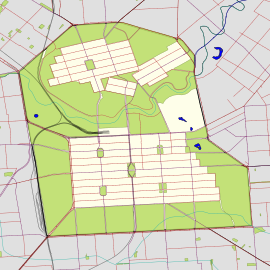
King William Street is the part of a major arterial road that traverses the CBD and centre of Adelaide, continuing as King William Road to the north of North Terrace and south of Greenhill Road; between South Terrace and Greenhill Road it is called Peacock Road. At approximately 40 metres (130 ft) wide, King William Street is the widest main street of all the Australian State capital cities. Named after King William IV in 1837, it is historically considered one of Adelaide's high streets, for its focal point of businesses, shops and other prominent establishments. The Glenelg tram line runs along the middle of the street through the city centre.

Woodville is a suburb of Adelaide, situated about 8 km (5.0 mi) northwest of Adelaide city centre. It lies within the City of Charles Sturt. The postcode of Woodville is 5011. Woodville is bound by Cheltenham Parade to the west, Torrens Road to the north, Port Road to the south and Park Street to the east, excluding the area of Cheltenham Park Racecourse. The population was 2,180 at the 2021 Australian census.
Keswick is an inner south-western suburb of Adelaide, adjacent to the park lands, and located in the City of West Torrens. The suburb is home to the Keswick Barracks, the headquarters of the Royal District Nursing Service, the Keswick Cricket Club and Richmond Primary School.
This is a timeline of Adelaide history.

Anzac Highway is an 8.7-kilometre-long (5.4 mi) main arterial road heading southwest from the city of Adelaide, the capital of South Australia, to the beachside suburb of Glenelg.

Ovingham is an inner northern suburb of Adelaide, South Australia. It is located in the cities of Charles Sturt and Prospect.
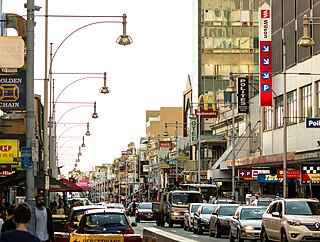
Hindley Street is located in the north-west quarter of the centre of Adelaide, the capital of South Australia. It runs between King William Street and West Terrace. The street was named after Charles Hindley, a British parliamentarian and social reformist.
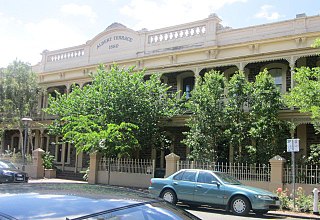
Carrington Street is a street in the south-eastern sector of the centre of Adelaide, South Australia. It runs east–west, from East Terrace to King William Street, blocked at Hutt Street and crossing Pulteney Street at Hurtle Square. It is one of the narrow streets of the Adelaide grid, at 1 chain wide.

Grote Street is a major street running east to west in the western half of Adelaide city centre, South Australia. It is on the northern border of Chinatown and the Adelaide Central Market, and is a lively centre for shopping and restaurants. The historic Her Majesty's Theatre is located here.

Franklin Street is a main street in the Adelaide city centre, South Australia.

Wakefield Street is a main thoroughfare intersecting the centre of the South Australian capital, Adelaide, from east to west at its midpoint. It crosses Victoria Square in the centre of the city, which has a grid street plan. It continues as Wakefield Road on its eastern side, through the eastern Adelaide Park Lands.

North Adelaide is a predominantly residential precinct and suburb of the City of Adelaide in South Australia, situated north of the River Torrens and within the Adelaide Park Lands.
W. H. Burford and Sons was a soap and candle-making business founded in Adelaide in 1840 by William Henville Burford (1807–1895), an English butcher who arrived in the new colony in 1838. It was one of the earliest soapmakers in Australia, and up to the 1960s when it closed, the oldest. In 1878 he took his two sons Benjamin and William into partnership as W. H. Burford & Sons. Its expansion, accompanied by a number of takeovers, made it the dominant soap manufacturer in South Australia and Western Australia. Its founders were noted public figures in the young city of Adelaide.
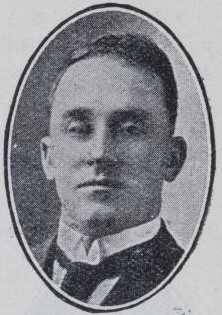
Thomas Patrick Howard was an Australian trade unionist and politician. He was a member of the South Australian House of Assembly from 1933 to 1938, representing the Lang Labor Party (1933), South Australian Lang Labor Party (1933–1934) and Labor Party (1934–1938).

William George Torr MA, BCL, LLD, often referred to as "Old Oxford", was a religious educator in South Australia.

The Jubilee Exhibition Building in Adelaide, South Australia, was built to celebrate the 50th anniversary of Queen Victoria's accession to the throne on 20 June 1837. The jubilees of her Coronation on 28 June 1838, and of the Proclamation of South Australia on 28 December 1836, were also invoked on occasion.
Violet May Plummer was a South Australian medical doctor, one of the first women from the University of Adelaide to graduate in medicine, [the first was Laura Margaret Hope née Fowler] and in 1900 was the first woman General Practitioner to practise in Adelaide.
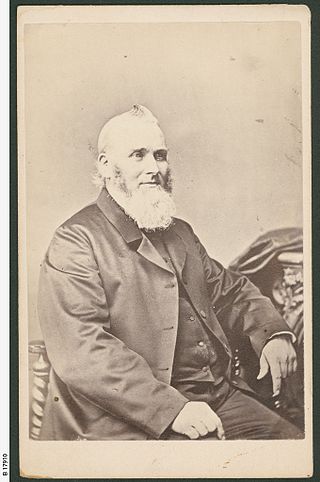
Rev. James Maughan was a Methodist minister in Adelaide, South Australia. His name was commemorated in the Maughan Church, Franklin Street, which has since been demolished.
Francis Lymer Gratton ATCL was a teacher and choral conductor in South Australia, known for his leadership of the Thousand Voices Choir.

Dan Clifford was a well-known cinema entrepreneur and philanthropist in South Australia. He was also a keen promoter of the cinema industry, and owned 20 cinemas across the state at the time of his death, including several in Art Deco style, such as the Piccadilly Theatre and the Goodwood Star.


